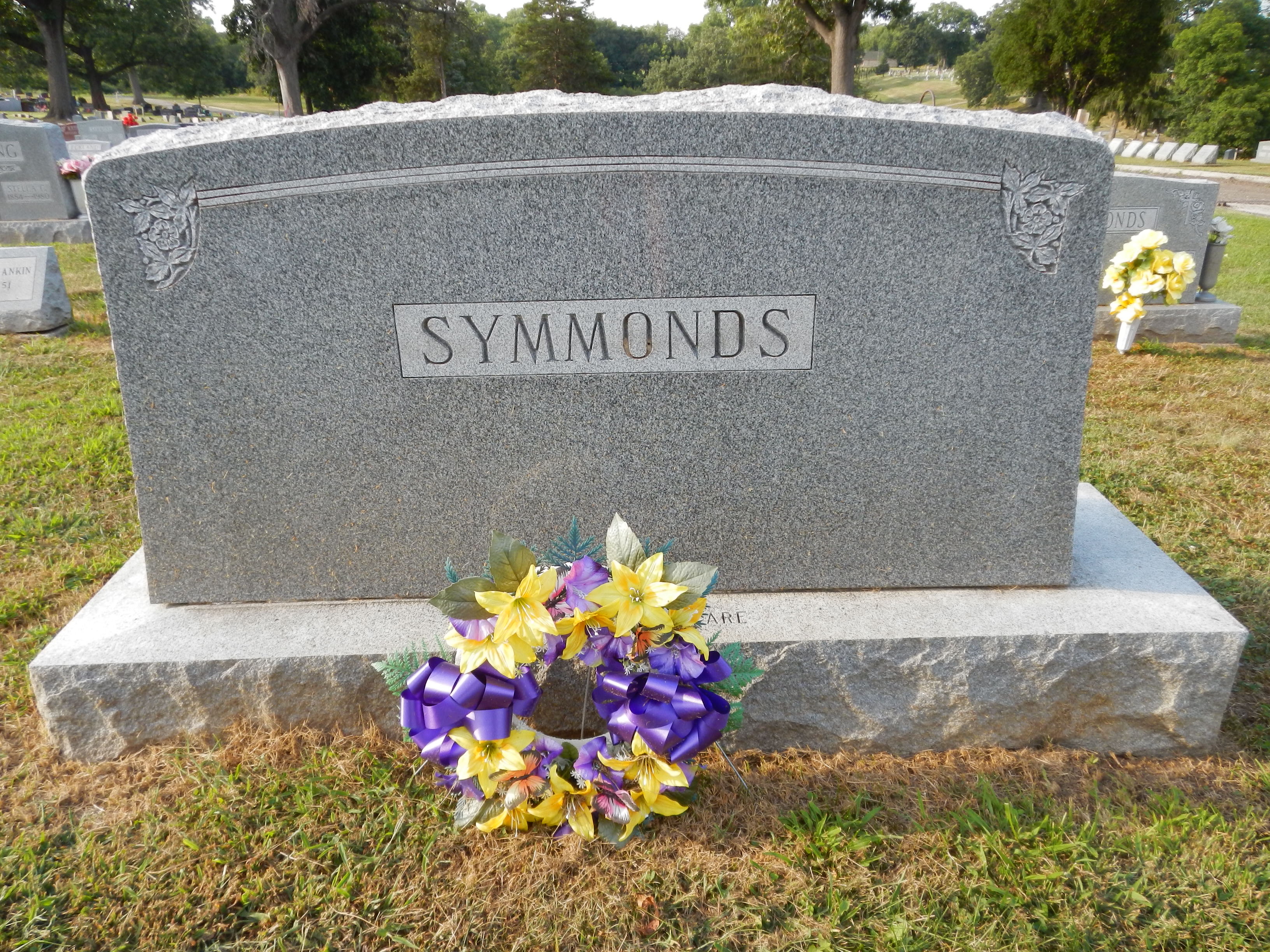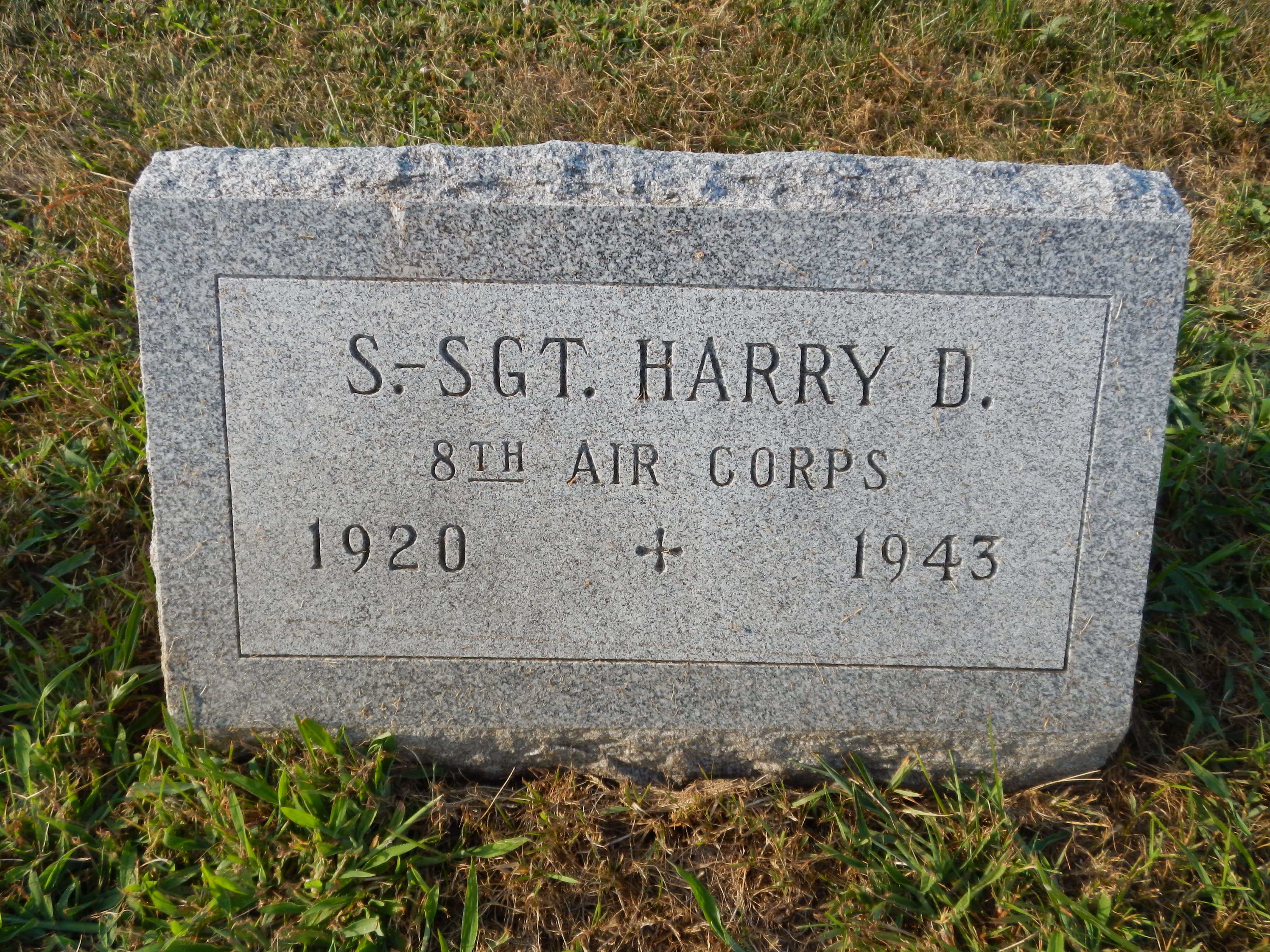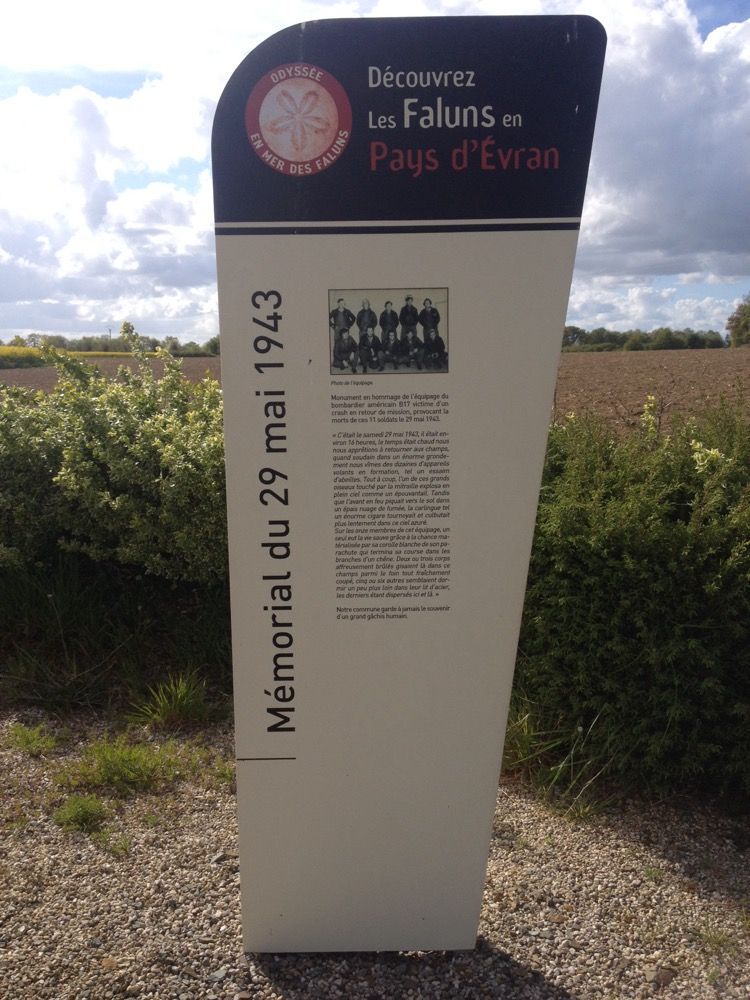Buried on Jan 6, 1949 in a box by Schmidt Funeral Home.
Website (http://www.absa3945.com) listed S/Sgt Harry D. Symmonds as KIA. On May 29, 1943, Les Champs Gerauz, B-17F-55-BO, "Snafu", #42-29476, Code GL-M, 94th BG/410th BS.
------------------------------
French service to pay tribute to Keokukian
By Cindy Iutzi/Gate City Staff Writer (www.dailygate.com)
All who have benefited from the ultimate sacrifice made by American servicemen and women - from residents of a small village in France to citizens of the Tri-State Area - have a special day to keep the memories of their loved ones alive.
Most Memorial Day services in the Tri-State Area are Monday, but days later, a memorial ceremony will take place at Les Champs Geraux, "a little village in Brittany, 45 kilometers northwest of Rennes," according to a Web site about the crash of a B-17 named SNAFU on May 29, 1943, in France (www.b17-29mai.com).
A memorial will be dedicated exactly 50 years later, to the day, in memory of the 10 men who died there.
One of the gunners in SNAFU was Harry "Dibby" Symmonds of Keokuk, late uncle to several nieces and nephews, including Hurshel Symmonds of Hamilton, Ill.
Dibby was the son of Hurshel and Lillie Symmonds and brother to seven siblings: two brothers and five sisters. The family lived in several different homes and locations throughout the Tri-State Area as the children were growing up.
Their father, Hurshel Sr., farmed and was employed by Electro Metals (most recently Ferro-Sil) in Keokuk.
"As soon as they were over enemy territory, they were attacked by fighters of the Luftwaffe … SNAFU was under attack and hit …" the Web site's narrative says. "The radio operator, Sgt. Herman Philbeck, will remember all his life, the last minutes of the death of his friends, his oxygen mask on fire, his ejection from the breaking downing [sic] B-17.
"Herman recovered from his unconsciousness and pulled out his parachute. He was made a POW. The rest of the crew was not so fortunate … Lea, Francois and Eugene, some of the witnesses, still remember the noisy sound of the explosion and the crash of the B-17. They still have the memory of this sad event."
Dibby was 23 when he died in France.
"He became for his nephews and nieces the one who didn't come back from the war," the narrative says. "His family didn't accept for a long time, the fatality."
Dibby's nephew, Richard Van Dyke of Gales Ferry, Conn., researched the 94th Bomb Group, of which SNAFU was a part, and wrote a book about his uncle, "The Sky Keeps No Memories." The book is subtitled "The 94th Bomb Group: An American Airman and His Letters, 1942-43."
Van Dyke chronicles Dibby's life as the second oldest of five children still living at home when he was called up to serve. He was 21 and farmed with his father.
"His older brother, Dick, 22, had already gone off to war, serving with the Army Corps of Engineers in New Guinea in the South Pacific," Van Dyke writes. His brother, Hurshel Jr., 23, "was still in Keokuk, but on June 10th would be headed for service with the Sea Bees."
The Symmonds family sent all their sons to war, each to a different branch of the service.
A month after Dibby registered for the draft, Secretary of War Henry Stinson drew his number, 967, from a goldfish bowl in Washington, D. C. on March 17, 1942.
Dibby left home May 18, 1942, for Fort Des Moines and was sent on to the Air Corps training at Jefferson Barracks, Mo., and then to gunnery school in Las Vegas.
He grew a mustache, took up trap and skeet shooting to sharpen his gunnery eye and wrote home saying that he missed his mother's fried chicken.
Dibby flew six missions into Europe. In his last letter home, published in Van Dyke's book, he seemed to be full of plans and asked for a late birthday present.
Dear Moms:
Not much doing tonight, so I thought I'd drop you a line … Say moms, remember that camera you wanted to get me for my birthday? I wonder if you can still get one? I wish you'd send me one if it's at all possible. I'll have a chance to take some good shots later on. Also send an extra roll of film or two … Well, this is all for tonight, so, so long till next time.
Love,
Dibby
"Six days later, on his next mission, S/Sgt Harry D. Symmonds was listed missing in action," Van Dyke wrote.
Later, his parents received official word that he died in the crash.
Dibby's brothers survived the war. Hurshel came home from his service in the Sea Bees but drowned while testing a new outboard motor in Chatfield Lake in Powdertown, April 5, 1948.
Richard came home after three grueling years in the South Pacific, married Geraldine Oehmigen, Aug. 28, 1947, and had three children.
According to Richard's son, Hurshel Symmonds of Hamilton, he built airfields on islands in the Pacific as the Allies moved closer to Japan. The men worked in 12-hour shifts and were strafed and bombed by day, rebuilding airstrips by night.
"Dad didn't like to talk about it a whole lot," Symmonds said. "I think it was quite traumatic. At night they were bulldozing for an airstrip and a giant boa constrictor came down on the hood. He and a guy he was training jumped off to get away from the snake. It was huge."
He told his son of having to requisition a new tent every two weeks because the mold would rot the canvas.
When Richard was very ill and nearing the end of his life at 81 years, he had flashbacks, Symmonds said. He would remember "when the Japanese killed people they would put their head on poles for the men to see.
"One time he remembered when an American pilot had three or four Japanese Zeros chasing him. He swung around the island so the ground forces would know and see them coming so they could shoot them down. He (the pilot) had no ammunition left. After he landed, he went around and opened the back bay area where the spent shells go and thousands of rounds fell out. However many rounds he had, he used them all."
All three brothers are together, buried in Oakland Cemetery, in Keokuk.
Harry had been buried in France, but was exhumed and shipped to the United States to be buried with his family.
Buried on Jan 6, 1949 in a box by Schmidt Funeral Home.
Website (http://www.absa3945.com) listed S/Sgt Harry D. Symmonds as KIA. On May 29, 1943, Les Champs Gerauz, B-17F-55-BO, "Snafu", #42-29476, Code GL-M, 94th BG/410th BS.
------------------------------
French service to pay tribute to Keokukian
By Cindy Iutzi/Gate City Staff Writer (www.dailygate.com)
All who have benefited from the ultimate sacrifice made by American servicemen and women - from residents of a small village in France to citizens of the Tri-State Area - have a special day to keep the memories of their loved ones alive.
Most Memorial Day services in the Tri-State Area are Monday, but days later, a memorial ceremony will take place at Les Champs Geraux, "a little village in Brittany, 45 kilometers northwest of Rennes," according to a Web site about the crash of a B-17 named SNAFU on May 29, 1943, in France (www.b17-29mai.com).
A memorial will be dedicated exactly 50 years later, to the day, in memory of the 10 men who died there.
One of the gunners in SNAFU was Harry "Dibby" Symmonds of Keokuk, late uncle to several nieces and nephews, including Hurshel Symmonds of Hamilton, Ill.
Dibby was the son of Hurshel and Lillie Symmonds and brother to seven siblings: two brothers and five sisters. The family lived in several different homes and locations throughout the Tri-State Area as the children were growing up.
Their father, Hurshel Sr., farmed and was employed by Electro Metals (most recently Ferro-Sil) in Keokuk.
"As soon as they were over enemy territory, they were attacked by fighters of the Luftwaffe … SNAFU was under attack and hit …" the Web site's narrative says. "The radio operator, Sgt. Herman Philbeck, will remember all his life, the last minutes of the death of his friends, his oxygen mask on fire, his ejection from the breaking downing [sic] B-17.
"Herman recovered from his unconsciousness and pulled out his parachute. He was made a POW. The rest of the crew was not so fortunate … Lea, Francois and Eugene, some of the witnesses, still remember the noisy sound of the explosion and the crash of the B-17. They still have the memory of this sad event."
Dibby was 23 when he died in France.
"He became for his nephews and nieces the one who didn't come back from the war," the narrative says. "His family didn't accept for a long time, the fatality."
Dibby's nephew, Richard Van Dyke of Gales Ferry, Conn., researched the 94th Bomb Group, of which SNAFU was a part, and wrote a book about his uncle, "The Sky Keeps No Memories." The book is subtitled "The 94th Bomb Group: An American Airman and His Letters, 1942-43."
Van Dyke chronicles Dibby's life as the second oldest of five children still living at home when he was called up to serve. He was 21 and farmed with his father.
"His older brother, Dick, 22, had already gone off to war, serving with the Army Corps of Engineers in New Guinea in the South Pacific," Van Dyke writes. His brother, Hurshel Jr., 23, "was still in Keokuk, but on June 10th would be headed for service with the Sea Bees."
The Symmonds family sent all their sons to war, each to a different branch of the service.
A month after Dibby registered for the draft, Secretary of War Henry Stinson drew his number, 967, from a goldfish bowl in Washington, D. C. on March 17, 1942.
Dibby left home May 18, 1942, for Fort Des Moines and was sent on to the Air Corps training at Jefferson Barracks, Mo., and then to gunnery school in Las Vegas.
He grew a mustache, took up trap and skeet shooting to sharpen his gunnery eye and wrote home saying that he missed his mother's fried chicken.
Dibby flew six missions into Europe. In his last letter home, published in Van Dyke's book, he seemed to be full of plans and asked for a late birthday present.
Dear Moms:
Not much doing tonight, so I thought I'd drop you a line … Say moms, remember that camera you wanted to get me for my birthday? I wonder if you can still get one? I wish you'd send me one if it's at all possible. I'll have a chance to take some good shots later on. Also send an extra roll of film or two … Well, this is all for tonight, so, so long till next time.
Love,
Dibby
"Six days later, on his next mission, S/Sgt Harry D. Symmonds was listed missing in action," Van Dyke wrote.
Later, his parents received official word that he died in the crash.
Dibby's brothers survived the war. Hurshel came home from his service in the Sea Bees but drowned while testing a new outboard motor in Chatfield Lake in Powdertown, April 5, 1948.
Richard came home after three grueling years in the South Pacific, married Geraldine Oehmigen, Aug. 28, 1947, and had three children.
According to Richard's son, Hurshel Symmonds of Hamilton, he built airfields on islands in the Pacific as the Allies moved closer to Japan. The men worked in 12-hour shifts and were strafed and bombed by day, rebuilding airstrips by night.
"Dad didn't like to talk about it a whole lot," Symmonds said. "I think it was quite traumatic. At night they were bulldozing for an airstrip and a giant boa constrictor came down on the hood. He and a guy he was training jumped off to get away from the snake. It was huge."
He told his son of having to requisition a new tent every two weeks because the mold would rot the canvas.
When Richard was very ill and nearing the end of his life at 81 years, he had flashbacks, Symmonds said. He would remember "when the Japanese killed people they would put their head on poles for the men to see.
"One time he remembered when an American pilot had three or four Japanese Zeros chasing him. He swung around the island so the ground forces would know and see them coming so they could shoot them down. He (the pilot) had no ammunition left. After he landed, he went around and opened the back bay area where the spent shells go and thousands of rounds fell out. However many rounds he had, he used them all."
All three brothers are together, buried in Oakland Cemetery, in Keokuk.
Harry had been buried in France, but was exhumed and shipped to the United States to be buried with his family.
Sponsored by Ancestry
Advertisement
Explore more
Sponsored by Ancestry
Advertisement





